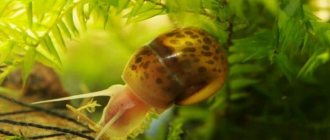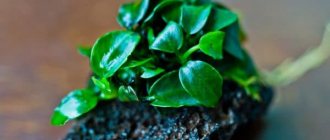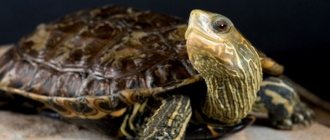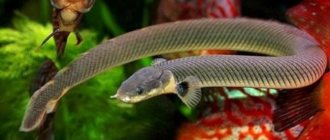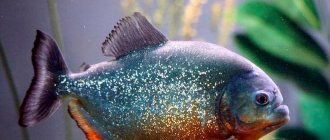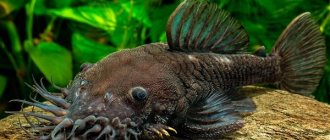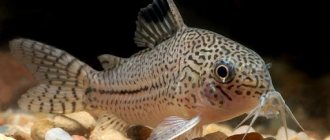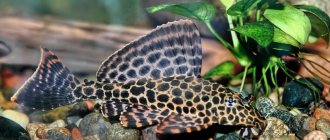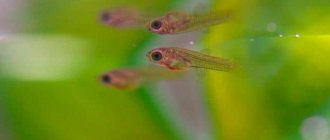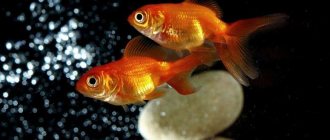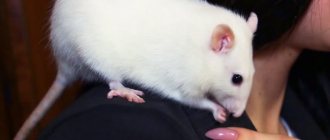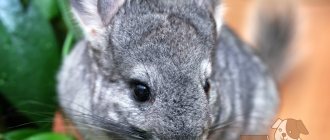Maintenance and care, arrangement of the aquarium
The optimal size of an aquarium for one adult fish starts from 200 liters. The design is recommended to recreate conditions reminiscent of the natural habitat - a river bottom with a slow flow of water with a sandy substrate and an intricate labyrinth of tree roots and branches. Lighting should be dim. If you plan to use living plants, you will need to select shade-loving species that can attach to the surface of driftwood. Any vegetation that takes root in the ground will soon be dug up. A layer of leaves from some trees will complete the design. They will not only become part of the decor, but will also allow you to give the water a chemical composition similar to that in which Ancistrus vulgaris lives in nature. As the leaves decompose, they will begin to release tannins, particularly tannins, which turn the water brown and help lower pH and dGH values. Read more in a separate article “Which tree leaves can be used in an aquarium.” Like most other fish that come from undisturbed natural habitats, they are intolerant of the accumulation of organic waste and require impeccable water quality. For this purpose, regular aquarium maintenance procedures are carried out and a productive filtration system and other equipment are installed.
Care and maintenance
The catfish stuck almost all day long searching for and eating new food. Thus, it fights algae and food debris in the aquarium. He does this with the help of his suction cup. Inside the aquarium, they rarely reach a size larger than 15 cm. Despite their usefulness, they do not look so attractive to many: a suction cup mouth, dark color, mustaches near the mouth.
Ancistrus catfish (Latin name ancistrus dolichopterus) likes to hang upside down or hide under all sorts of objects, so it is very good to add ceramic pots, large driftwood, and coconuts to your aquarium. By the way, adding driftwood to an aquarium can not only provide shelter, but also be beneficial for their digestion. The fact is that wood contains lignin, by scraping which fish improve their digestion. The cleaner catfish actively eats leftover food, but at the same time actively excretes waste products, so it is advisable to install a good filter in the aquarium.
As stated above, catfish are rightfully considered one of the most resistant species; Ancistrus requires minimal maintenance and care, and you really need to try hard to ensure that the aquarium conditions do not suit it. But let’s give an approximate characteristic that will be most favorable for him:
- Water parameters: pH 6–7.3 dH up to 10°, KH up to 2°, water hardness no more than 20–25 dH;
- Water temperature: 20–26 °C (ideal 22 °C).
They love clean water with a lot of oxygen, so don’t forget to change it periodically and also provide aeration. An interesting observation is that sucker catfish are larger in size, as a rule, the lower the water temperature.
What to feed Ancistrus
Sticky fish love to eat, but in addition to leftover food, they will gladly eat:
- plant foods based on spirulina (can be found in tablets, they dissolve well in water and attract with their smell);
- frozen food (bloodworm or coretra);
- vegetables (scalded pieces of zucchini, cucumbers, spinach, peas, pumpkin or lettuce, cabbage);
- tubifex worms, insect larvae, daphnia, cyclops or other worms.
To avoid contaminating the water, be sure to remove any uneaten remains. In general, catfish adhere to lovers of plant food, but when there is a lack of nutrition, they switch to a live diet. 70–80% plant foods and 20–30% protein are recommended. Follow the rule that food should not be monotonous; food should be both live and dry.
Due to the fact that sucker fish are quite active, they require quite a lot of space, so the aquarium should be spacious. For a couple (male and female), the recommended aquarium volume is 80 liters or more. Of course, they can be kept in smaller volumes, but most often the fish in a smaller volume dies. With proper care, aquarium cleaners live quite a long time. Ancistrus live 6–8 years, although sometimes they live longer, for example, up to 12.
Short story
Ancistrus are a very popular aquarium fish, known since the early 1900s, that have earned a reputation as champion algae killers.
Unfortunately, both before and now there is confusion in the identification of species of the genus Ancistrus. The situation is further complicated by hobbyist aquarists who give different, speculative scientific names to almost every imported species. The most common among them are: A. cirrhosus, A. temminicki and A. dolichopterus. Although most wild specimens are extremely difficult to assign to a specific species, the situation has improved slightly in recent years.
Ancistrus cf. cirrhosus was for a long time known simply as Ancistrus sp. (3). This is the most common and accessible of the ancistrus, coming to the market from fish farms in Southeast Asia and Florida. Its specific characteristics have not been determined, so there is still an opinion that it is a hybrid. However, this is doubtful because the species has been bred for a long time without any variation, and specimens found in Europe, Australia and the United States appear to be the same species. Breeding practices have led to the emergence of albino (A. sp. 4), veiled (A. sp. 5) and even albino veiled forms.
Ancistrus cf. cirrhosus (Ancistrus sp. (3)) with juveniles (ill. www.istellas.gr)
Ancistrus triradiatus (aka LDA 72) is most often exported in the wild. Representatives of this species are caught in large quantities near the city of Villavicencio, Colombia. They inhabit waters at the base of mountains and can withstand relatively low temperatures (down to 22 °C). These catfish prefer fast water with a high oxygen content, but adapt to other conditions.
Ancistrus triradiatus (LDA 72) (ill. dfcdfc69; alquimistadeacuarios.com/foro/viewtopic.php?t=50031)
True specimens of Ancistrus dolichopterus (aka L183) are supplied from Rio Negro, Manaus. These attractive blackwater inhabitants require soft, warm water.
Ancistrus and its compatibility with other fish
If we talk about how the ancistrus will get along with other fish, then dry statistics come into play - it will get along perfectly. Is it with all the fish? Unfortunately, no, and let's look at why.
Ancistrus can be dangerous for large, slow-moving fish that lack scales. Crawling over a large object, without any malicious intent, catfish can damage the skin of fish.
But not only danger can come from ancistrus. Large cichlids are dangerous enemies of our cute catfish. There is a suspicion that cichlids that build nests on the bottom regard ancistrus as a potential threat to encroach on their nests, and this is already a reason to attack. Try to avoid the proximity of large aggressive cichlids to Ancistrus. Even their chain mail armor may not save the latter.
Recommendations
The aquarium fish Corydoras is suitable for both beginners and experienced aquarists. Possessing a peaceful character, it gets along well with many fish, except aggressive predators. Undemanding to environmental conditions. He spends most of his time at the bottom, rummaging in the soil, performing the function of an aquarium orderly. Easily reproduces in captivity. With proper care, it will delight its owners with offspring and live up to 15 years.
Previous
FishWhat the corridor itself needs for a comfortable stay
Next
FishEasy to keep pearl gourami
Diseases of catfish
When buying fish, many people do not even suspect that their pets can get sick. Identifying the disease in catfish can be problematic, because the fish are nocturnal and rarely swim out for public viewing in daylight. Ancistrus may experience a number of health problems:
- White spots on the fish's body may appear due to stress. In this case, we are not talking about illness, but about stress staining. In a stressful situation, ancistrus become dull and partially lose pigmentation. This can happen when transplanting a catfish from a familiar container to another aquarium, as well as after transportation. The infectious disease in the form of white spots can be carried by other fish. Therefore, after acquiring new neighbors for the catfish, they must be kept in a quarantine tank for at least 2 weeks. If the color of the catfish has changed and spots have appeared, it is also isolated. Quarantine and treatment last for at least 14 days. For treatment, purchase the drug Antipar.
- Ichthyophthiriasis resembles a scattering of semolina on the body of a fish. The disease is caused by the ciliate ichthyophthirius. For treatment, potassium permanganate, copper sulfate, malachite greens and formaldehyde are used. These substances can lead to the death of algae and invertebrates inhabiting the aquarium.
- Velvet disease or oodiniosis may not manifest itself for a long time, but under unfavorable conditions (stress, changes in water parameters) it will begin to progress. Sick individuals are characterized by reduced activity. Their fins turn into fragments of sharp rays, on which there is no interray tissue. The fish's skin will begin to peel off, and the body will resemble velvet fabric. Without treatment with antibiotics, the disease cannot be controlled. For 100 liters of water you will need 1 bottle of Bicillin-5. On the second day, perform a partial water change (30%) and repeat the administration of the drug. After 48 hours, the treatment is repeated, a control administration of the drug is carried out a week later. The treatment is considered effective, but the algae die.
- With chilodonellosis, cloudy areas of a bluish tint appear on the sides and back of the fish. It is necessary to examine the caudal fin if it is tightly compressed but not disheveled - this is a sure sign of disease. Levomycetin is used for treatment. For 100 liters of water, 3 g of the drug is needed. The product is added 3 times, maintaining 48-hour intervals. Before adding the dissolved drug, the water in the aquarium is replaced by 1/3. Additionally, you can raise the temperature in the aquarium to +28-30°C and add 3 tbsp to the water. salt. But such an additive will contribute to the death of algae.
- Dropsy is hard to miss. The catfish's belly swells and it stops defecating. For treatment, it is necessary to remove the sick individual and add Levomycetin (75 ml/l) or Ciprofloxacin (50 ml/l) to the water. The water temperature must be at least +27°C. Treatment is carried out for several days in a row. Effectiveness is indicated by a shrinking belly and the appearance of bowel movements.
Editorial: Tetra penguin
Ancistrus starata is a good choice for a freshwater aquarium. The peaceful existence of the catfish with other fish will allow it to rationally fill all layers of the home pond.
Diseases
Ancistrus catfish are not in poor health, but some diseases also affect them. A common cause of disease is failure to maintain cleanliness and hygiene of the aquarium, untimely change of water, and rotting of food particles stuck between stones. Therefore, the best prevention of diseases in the aquarium inhabitants is timely cleaning and replacement of water.
In order to promptly determine the deteriorating health of ancistrus, you need to monitor the condition of your pets every day. If you recognize the disease in advance, it can be easily cured.
Symptoms of a sick catfish:
- Unusual behavior, uncharacteristic actions. Sluggish and inhibited or overly active behavior in combination with other symptoms indicates some kind of disturbance in the body.
- Change in fish color. More often the yellow color fades and loses its brightness. But this also happens after the spawning process, so this symptom is inaccurate.
- Poor appetite or its complete absence. Healthy fish are always ready to feed and swim to the place of food. And the patient remains in the shelter and does not touch the food.
- The formation of unhealthy plaque on the skin and scales.
Fish with one or more symptoms are separated from the others. Most often, catfish are affected by fin rot, swim bladder disorder and bacterial diseases.
Habitat
Under natural conditions, ancistrus are found mainly in South America, mainly in the mountain tributaries of the Amazon in the Peruvian part of the Andes, as well as in the upper reaches of the Orinoco River in Venezuela. Ancistrus was presumably brought to Russia in the 1970s.
In the wild, this fish lives in fast-flowing, shallow mountain streams. This is due to the absence of a swim bladder and the presence of a powerful oral sucker, which makes it easy to stay on the rocks even in strong currents, as well as a strong shell that protects against objects that the current can carry.
Features of Ancistrus catfish
This catfish is a unique fish because it differs from others in its unusual appearance and way of life. It has a suction cup mouth that sticks to aquarium walls, rocks, decorations and even plants. This mouth has horn-shaped scrapers that help clean objects around it, which is why it is called a cleaner.
Ancistrus does not swim, but moves in peculiar leaps. This catfish, unlike other fish, does not even have a swim bladder.
Under proper conditions in an aquarium, a catfish will live for about 7 years.
There are also visual differences between males and females. The male has tentacles (antennae) on his head. The female individual either does not have them, or the mustache is small and located on the sides. Ancistrus can also change sex. If a female lives alone for a long time, she can turn into a male.
If a female Ancistrus is alone for a long time, it can turn into a male.
As for coloring, the catfish has nothing to boast about. It has a dark gloomy color and is covered all over with white dots. Although, of course, like other species of fish, there are albinos, which have a bright yellow color.
So if a catfish is exploring the bottom, then at these moments it becomes an inconspicuous fish, which is even difficult to see.
The length of the stick reaches 10 cm, but if there is warm water in the aquarium, it will not reach them.
Varieties
In nature, there is a wide variety of Ancistrus catfish, the size of which ranges from 20 to 195 mm. Some varieties of this fish live in aquariums.
Ordinary
Ancistrus vulgaris is also called blue ancistrus. This name is due to the fact that young animals often have a blue tint to their scales and a white edging on their fins. Adult catfish usually boast varying shades of scales , ranging from yellowish-gray to dark gray. White spots are randomly located all over the body.
Veiled
This species has highly developed fins, and when moving they flutter like a veil in the wind. For this feature, the catfish got its name. The body color of the fish is mainly dark olive, with randomly located light spots. The movements are very smooth and resemble flapping wings, for which the subspecies received a second name - Ancistrus dragonfly.
Star-shaped
The incredibly beautiful colors, reminiscent of the starry night sky, became the source of the name of this variety. The body of the fish is black or so dark in color with spots of pearly white or bluish color that it feels like a piece of starry night is crawling along the bottom. Juveniles boast bluish edging on their dorsal and caudal fins. The first rays of the front fins of star ancistrus have small spines.
Star
A dark brown, almost black fish with small white or blue specks and thickened pectoral fins covered with prickly spines, it is very similar to the star ancistrus. The main difference will be the wide white edging of the fins, which is present in the fish throughout its life. Star stickers also have bone spines hidden at the base of their heads. At the moment of danger, the fish spreads them out to drive away enemies.
Diamond
One of the rarest numbered catfish is the diamond ancistrus L-184. Externally, the fish resembles its star-shaped counterpart, differing from the latter in a more saturated black color with large bright white spots. The color does not change even in adulthood.
Red or Super Red
A little-known new variety bred by German breeders. Characterized by incredibly bright brick-red or orange scales. Unlike other relatives, Ancistrus Red prefers to live an active life during daylight hours. Compared to other species, the body size of the fish is small, not exceeding 60 mm.
Golden albino
Ancistrus albino or golden ancistrus is a fish that has lost the pigmentation of its scales. Because of this, the body color acquired a beautiful golden beige hue. The eyes are pinkish, which is a characteristic feature of albinos. Like albinos of other living creatures, the lifespan of such fish is shorter than that of other varieties.
Yellow
The yellow catfish is one of the most famous species of stickfish, along with the common ancistrus. Outwardly, he strongly resembles an albino, differing from him only in the color of his eyes and the more saturated yellow color of his body. The yellow catfish has ordinary eyes.
Leopard
The golden leopard ancistrus is also called the tortoiseshell or russet leopard. The fish got its name because of its beautiful leopard-print color. The fry have dark brown spots scattered across their orange-red body. With age, the body color of the fish changes to golden yellow with pronounced dark spots. The breed was bred artificially and belongs to the numbered species. The official name of the catfish species is LDA-016.
If the leopard ancistrus has brown and gray spots on its body, then this color option is called tricolor or brindle.
Neighborhood among brothers
If we consider the intraspecific relationships of Ancistrus, then the concept that Ancistrus is a peaceful fish will be a little vague and not very correct. As one aquarist said - a peaceful fish under normal conditions!
What can be understood by normal conditions in the life of ancistrus? This, unfortunately, is not the conditions of detention, water parameters, length of daylight hours, or the regularity and variety of food.
Normal conditions in the life of these catfish can be called circumstances in which no one will need to prove or defend anything. What does it mean?
Normal conditions are when there is one pair of catfish in the aquarium, there is no need to take food from anyone, the male does not need to prove superiority over other males, when everyone has enough shelter and living space. Now let's look at these points in a little more detail.
Editorial: Multi-colored axolotls
Living space
As you know, even guppies will be reluctant to live in a three-liter jar. It's the same story with catfish. If you keep ancistrus in a common aquarium, then for one pair you need about 60-70 liters for comfortable living.
If you plan to keep more individuals, then approximately the same volume will be needed for each pair. Why, and what can happen if you do not follow this instruction?
A similar situation can arise in a fairly spacious aquarium that does not have enough hiding places. Ancistrus will also fight for apartments, so if you plan to keep more than 2 individuals of these catfish, then try to provide them with grottoes, caves, amphorae, halves of coconut shells and, of course, driftwood.
Snags are a separate point in the life of ancistrus. In addition to the fact that this is a natural shelter for this catfish, it is also food. By scraping off a layer of wood, catfish saturate the body with useful substances that help maintain health at the proper level.
Guests
When all your inhabitants in the aquarium have already gotten acquainted and come to some common denominator, everything seems to have become quiet and peaceful, no one is chasing anyone or getting nervous. But a resonance can be caused by new ancistrus that you add to this aquarium.
As before, males and females will need to show who is boss and let newcomers know where their place is. If we are talking about a spacious aquarium with a lot of space and hiding places, then such conflicts usually end quite quickly.
Fathers and Sons
As you know, after the female lays eggs, she needs to be removed from the aquarium or the spawning ground must be equipped with many shelters. This is due to the fact that the bearded loving ancistrus, after completing the spawning process, becomes an aggressive defender of the future offspring. And his aggression is so great that in some cases the females died under the pressure of a fierce defender.
The father carefully waves his fins near the eggs, stimulating the flow of water to the future babies, removes unfertilized or dead eggs from the clutch, and this will continue until the larvae begin to swim. Only after a couple of days can dad calmly return to his business.
But if we consider a common aquarium in which a couple of ancistrus spawned, then after a while, or rather after 7-10 months, when the fry reaches sexual maturity, the sons will already be regarded as competing males, and there will no longer even be any family connection in mind. Then the rule “who is stronger is right” comes into play.
How does mating happen?
For reproduction, a sexually mature pair of fish is needed, although many breeders advise that there should be several females for one male. The stimulus for the start of spawning is a protein diet. At this time, fish should be given bloodworms, brine shrimp, daphnia, and tubifex live or frozen.
Important! Catfish can eat their eggs, so for spawning and raising offspring it is necessary to provide two separate aquariums.
Let's look at the spawning of these fish using the example of corydoras. Usually the process begins early in the morning. The male stimulates the female with his antennae, tickling her back and sides. After this, it is positioned at right angles to the female’s head and releases milk.
Experts do not fully agree on how exactly fertilization of eggs occurs. Some of them believe that the female passes milk through her intestinal tract and releases it onto the eggs, which are located in the ventral fins. According to others, the milk passes only through the female’s gills and is directed along the body to the eggs.
After fertilization, the female glues the egg to a previously cleaned surface - glass, plant, filter. Once the eggs are laid, mating is repeated until all 200–300 eggs are fertilized. This may take an hour or even longer. Thus, in order to breed these fish, you just need to provide them with appropriate living conditions.
Feeding Ancistrus
Ancistrus are typical herbivorous catfish, so the basis of their diet should be food with a high proportion of vegetation. Too large a percentage of animal food can lead to digestive disorders in Ancistrus. Therefore, under no circumstances should you feed them only live and frozen food (bloodworms, brine shrimp, tubifex). Such food, in addition, may pose a risk of introducing infections into the aquarium.
An excellent choice would be specialized dry food for chain catfish:
- Tetra Pleco Veggie Wafers are dense plates that quickly sink to the bottom and become accessible to ancistrus, which happily scrape off such food. Thanks to their special structure, they retain their shape for a long time and do not cause cloudiness in the water. The green area in the center of the tablets is a concentrate of algae and zucchini for excellent digestion of chain catfish.
- Tetra Pleco Spirulina Wafers is a tablet food for herbivorous fish with an algae concentrate, additionally enriched with Omega-3 acids, which support the fish’s immunity. The composition includes a large amount of plant fibers, which ensure comfortable digestion of ancistrus. The plates retain their shape for a long time and do not muddy the water.
- Tetra Pleco Tablets are a universal food for all types of bottom-feeding fish that feed on vegetation. It has the form of bulk tablets and quickly sinks to the bottom, where it gradually releases food particles. The tablets are enriched with spirulina, an algae that not only supports comfortable digestion, but also gives additional vitality.
Bottom tablets with algae will appeal to ancistrus
It is enough to feed ancistrus once a day. It is advisable to throw the food tablets after turning off the main lighting.
Diet before spawning
Reproduction of ancistrus in a home aquarium requires certain feeding before being sent to the spawning grounds. A few weeks before this event, it is necessary to slightly improve the quality of the feed and increase its protein component from 20 to 50 percent of the total food. The strength of the young and its viability will depend on this.
It is preferable to feed catfish with frozen live food during this phase. For males, a protein diet is also very important. The male will not feed while he is caring for the clutch and later after the larvae.
Plant foods should also be present in the diet and be varied.
Before spawning, producers can be fed with fresh vegetables:
- bell pepper;
- cucumbers;
- asparagus;
- pumpkin;
- zucchini;
- carrot;
- cucumber;
- spinach.
Feeding future parents with combined minced meat based on sea fish and vegetables works very well.
Breeding at home
You can determine the sex of ancistrus by its head and the presence of mustaches
How to distinguish a female from a male
Determining the sex of ancistrus is quite easy, but this can only be done after the fish have reached sexual maturity, which occurs in the second year of life. At this time, skin growths (whiskers) are formed in males on the upper jaw, reaching 2 centimeters in length, while in females they are absent. At the same time, the body of the female is larger, longer and slender, and their fins are longer and sharper than those of the males.
Reproduction of Ancistrus
The male ancistrus takes on the role of parent and cares for the eggs throughout the entire ripening period.
Ancistrus become sexually mature in the second year of development. After this, they can spawn up to five to six times a year. They can breed independently in a community aquarium.
If breeding is carried out purposefully, then the selected male and female need to be separated. For this you can use a small spawning aquarium (40 l). It must be equipped with driftwood, as well as shelters in which the eggs will be laid. A filtration and aeration system is also necessary. It is recommended to treat the water with methylene blue, which will help eliminate fungal flora.
Editorial: Mastacembelus thailandis
You can identify a pregnant female by her “puffiness.” After this, preparation for spawning begins, and then the process itself:
The male very actively searches for the place where laying will take place, and then thoroughly cleans it. Over the course of a week, the female lays 30–100 small yellow, orange or pink eggs at night. The eggs are attached in clusters to the walls of the prepared shelter. At the end of the clutch, the male performs fertilization and drives the female out of the home. After this, it must be sent to a general aquarium. The male takes care of the offspring of Ancistrus.
He supplies oxygen to the clutch, fanning it with his fins, and removes non-viable eggs. During the ripening of eggs, you should not attract the attention of the male; if he panics, he can destroy the clutch. In good conditions, the larvae emerge within five days and feed on the gallbladder's reserves. When they run out, the larvae turn into fry.
Fry
The fry appear approximately two weeks after laying. During this period, they are fed live dust, ciliates, artemia nauplii, rotifers, microworms, crushed spirulina tablets, carefully crushed egg yolks and cucumbers. In the first month of development, food should be six times a day; subsequently, the fry are fed three times a day. After one and a half months from the moment of appearance, they can be moved to a common aquarium.
Problems with reproduction
With proper care and arrangement of the aquarium, problems with the reproduction of ancistrus do not arise. But if spawning does not occur for a long time, then it is recommended:
- change most of the water in the aquarium;
- increase the temperature;
- increase the amount of protein feed in the diet;
- Install cuttings of PVC pipes in the aquarium, in which fish like to breed.
Do you care about your pet's health? We are responsible for those we have tamed!” - says a quote from the story “The Little Prince”. Maintaining the health of a pet is one of the main responsibilities of the owner. Take care of your pet by giving him the Vitatame complex. The unique complex is designed for cats and dogs, as well as birds and rodents. Vitatame active supplement will help your pet shine with health and share happiness with you!
The average lifespan of ancistrus is about 7 years. There are cases where, with proper maintenance and feeding, individual individuals live more than 10 years.
Ancistrus catfish is a rather interesting aquarium fish. Despite its specific appearance, it is very popular among aquarists for its unpretentious maintenance and ease of breeding. In addition, it always adds a touch of exoticism to the fauna of the aquarium.
Determination of gender
The main sex differences appear by the eighth month of life and become fully apparent by about a year, when puberty ends. As a result, male catfish are smaller, more graceful in body structure and brighter in color than females.
Another characteristic difference is the thickness and shape of the abdomen. Males are usually leaner, with a flattened abdomen. In addition, the dorsal fins of females are much lower, and the caudal fins are much narrower. Males have more pronounced mustaches and skin growths on the head.
After observing your pets, you can notice differences in their behavior. While males can occasionally show aggression and even get into a fight, females are usually calmer.
Determining the sex of Corydoras: video
Reproduction
Having got a couple of catfish in an aquarium, it would be reasonable to expect offspring from the fish. You can distinguish a male from a female by small outgrowths similar to horns, which are located on the head of the ancistrus. In order for the pets to begin to reproduce, the best representatives are selected: a male and a female, which should be slightly larger than a boy.
It should be noted that during spawning many fish become aggressive, and ancistrus are no exception. Sticky catfish breed in a separate aquarium equipped with stumps, pots, snags or tubes, where the catfish lays its eggs. Despite the need to create a natural environment, the favorite place where catfish can calmly and easily reproduce is in plastic tubes. Also, during spawning, aquarists thoroughly clean the fish tank and install a filter and aerator to provide the pets with favorable conditions for reproduction.
The caring parent in a couple of catfish is the male Ancistrus. As soon as the fish has stuck and laid eggs, the male selflessly guards and fans the eggs with his fins to provide oxygen to the future offspring, and the father catfish also removes the dead eggs.
The larvae emerge from the eggs after five days. All this time, Ancistrus guards the babies, who practically do not move for two weeks. After this time, aquarists begin feeding the fry, giving the small catfish spirulina and ciliates, and later introduce plant and protein foods into the diet. Sticky catfish are interesting and useful aquarium inhabitants that will help the owner maintain cleanliness and order in an artificial pond. Despite the lack of bright and rich colors, ancistrus are unpretentious, energetic and hardy fish, for which many aquarists value sucker catfish.
Differences from Pterygoplichthas
Beginners in the aquarium hobby often confuse Ancistrus catfish with another variety of chain-mailed catfish, the Pterygoplicht fish. Despite their external similarity, these fish belong to different genera and in order to distinguish them, you need to know some of the characteristics of the fish.
- The coloring of young animals and adults of Pterygoplichthus does not differ. Young ancistrus have a light edging on their fins, which disappears with age.
- There is a peculiar pattern on the body of pterygoplichts: the older the individual, the less noticeable it is. Ancistrus have many colors of scales.
- Adult pterygoplichts grow whiskers on the lower jaw. Ancistrus males boast many distinctive horns on the top of their heads.
- Pterygoplichts have less pronounced sexual dimorphism.
- Unlike Ancistrus, Pterygoplichthus is incapable of breeding in aquariums.
- Sticky catfish live 7–8 years in aquariums , pterygoplicht can live twice as long - about 15 years.
Feeding Ancistrus
The favorite food for ancistrus is algal fouling, which very often appears on the walls of the aquarium or decorations when there is excess lighting. These fish are one of the most effective helpers in cleaning an aquarium. In addition, they happily eat leftover food for other fish. If there is a lack of food, ancistrus can switch to the tender parts of living plants, in which they can gnaw a hole or eat the whole thing. In aquariums with ancistrus, it is extremely useful to have natural driftwood; by gnawing on them, the fish obtain the cellulose necessary for comfortable digestion. Often, many aquarists feed their pets with vegetation from their table: scalded lettuce, cabbage or zucchini. Unfortunately, this method of feeding in some cases can lead to contamination of the aquarium, especially if leftover food is not removed. In addition, it should be remembered that the food must be nutritious and balanced.
You can feed catfish with tablets once a day before turning off the lights in the aquarium. If other fish attack the catfish tablets, you can place them directly in the ancistrus’ favorite hiding place. The number of feeding tablets must be calculated independently, depending on the number and size of ancistrus.
Reviews
Aquarists speak positively about Corydoras. Although the timidity of catfish seems like a drawback for some.
